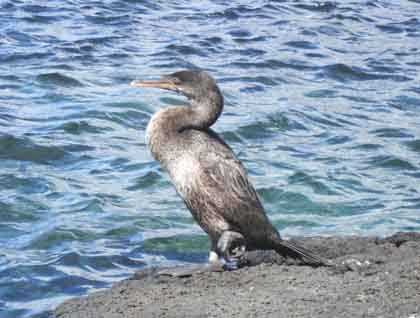Two of the most impressive and varied visiting sites in the archipelago, surrounded on all sides by huge shield volcanoes and separated by Bolivar Channel, are Fernandina and Isabela Islands. After a long navigation from Rabida Island, we finally arrived to the westernmost area of the Galapagos; with the first beams of sun, we had the opportunity to observe the marine life and the gigantic Ecuador volcano, its summit still clouded with great evidence of very explosive eruptions, which occurred a long time ago. The sea was very calm and many marine birds such as storm petrels, shearwaters and blue-footed boobies in feeding frenzy tried to catch some fish.
After breakfast we landed at Fernandina Island. As soon as we start walking along the seashore, we were able to observe hundreds of marine iguanas warming their blackish bodies on the petrified lava rocks. From time to time we heard them sneezing, secreting the excess salt from their bodies. It was cloudy and windy—very cold for these endemic reptiles that learned the only way to survive during these conditions is to stay together, like a pile of grapes. Walking along the white beaches we observed Galapagos sea lions, a banded Galapagos snake and marine iguana nests. We crossed the black lava field to get to the shallows, an imperturbable area with sea turtles, sea lions and school of fish swimming indifferently, while up in the treetops a Galapagos hawk observed the rocks, looking for a prey, mostly marine iguanas or lava lizards. Walking back to the small dock, we stopped on a small beach where a couple of sea lions rested, floating on the ocean surface. The water was very shallow and clear, when suddenly an octopus appeared from among the rocks, swimming close to the shore, and in one quick movement, a sea lion caught the big octopus, strangling it with its powerful fangs. It took several minutes for the sea lion to succeed, as the octopus squirmed its body, until finally we observed it swallowing that delicious prey, while small terns tried to steal a few morsels.
In the afternoon we dropped anchor in Punta Vicente Roca at Isabela Island, just beside the Ecuador volcano; it looked impressive with big waves breaking along the rocks and clouds encircling the top. We started our afternoon activities with a snorkeling excursion along the shore, observing the petrified lava rocks along the bottom, a great number of sea turtles that remained unperturbed in our presence. Dashing through the water like small torpedoes, two Galapagos penguin tried to catch some fish, and from the rocks flightless cormorants walked or jumped off the rocks to start their daily search for food. It was late when the National Geographic Endeavour moved north crossed the equator line. In a special ceremony, we were visited by pirates and shared great moments with our guests out on deck, crossing the Ecuadorian flag. We enjoyed a beautiful sunset that indicated the end of this wonderful day, leaving memories in our minds of these incredible places and remarkable creatures in this unique paradise called Galapagos.









